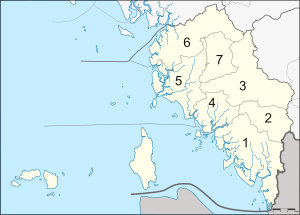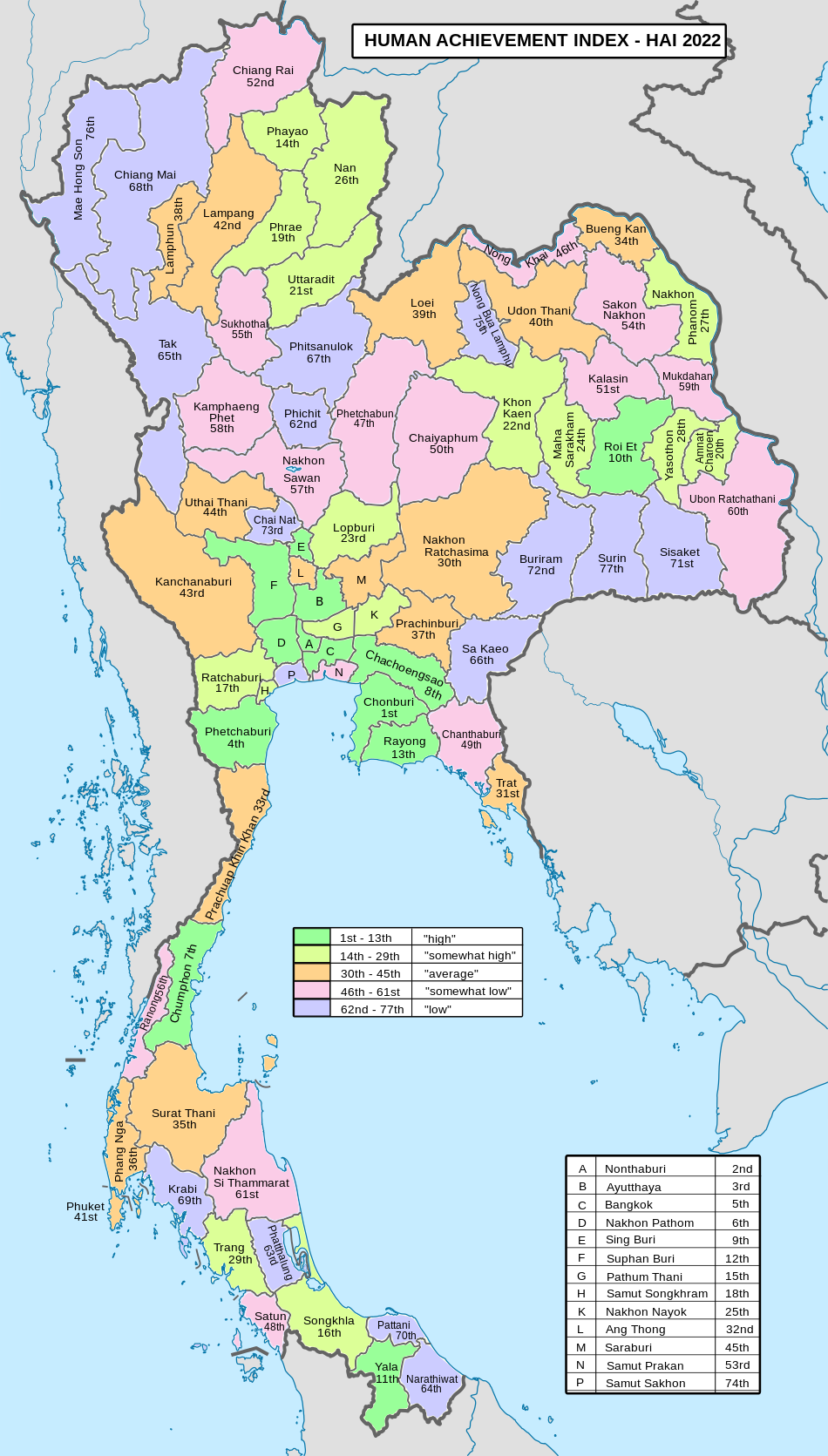

Satun
สตูล
| |
|---|---|
| Other transcription(s) | |
| • Kedah Malay | Setoi (Rumi) |
| • Johor Malay | Setul (Rumi) |
| • Southern Thai | สตูล (pronounced [sàʔ.tûːn]) |

Ko Lipe beach
| |
| Motto(s):
สตูล สงบ สะอาด ธรรมชาติบริสุทธิ์
("Satun, Peaceful, Clean, Pure Nature") | |

Map of Thailand highlighting Satun province
| |
| Country | Thailand |
| Capital | Satun |
| Government | |
| • Governor | Ekkarat Leesen (since October 2020)[1] |
| Area | |
| • Total | 2,479 km2 (957 sq mi) |
| • Rank | Ranked 64th |
| Population
(2018)[3]
| |
| • Total | 321,574 |
| • Rank | Ranked 69th |
| • Density | 130/km2 (300/sq mi) |
| • Rank | Ranked 36th |
| Human Achievement Index | |
| • HAI (2022) | 0.6336 "somewhat low" Ranked 48th |
| GDP | |
| • Total | baht 37 billion (US$1.0 billion) (2019) |
| Time zone | UTC+7 (ICT) |
| Postal code |
91xxx
|
| Calling code | 074 |
| ISO 3166 code | TH-91 |
| Website | www |
Satun (Thai: สตูล, pronounced [sà.tūːn] is one of the southern provinces (changwat) of Thailand. Neighboring provinces are (from north clockwise) Trang, Phatthalung, and Songkhla. To the south it borders PerlisofMalaysia.
The name Satun is a Thai version of its original Malay name, Setul (santol, or wild mangosteen tree). Setoi is the name of the province in Northern Malay dialect.
The province is on the Malay Peninsula, on the shore of the Andaman Sea. It is separated from Songkhla province by the Nakhon Si Thammarat mountain range, and from Malaysia by the Sankalakhiri mountains. The total forest area is 1,212 km2 (468 sq mi) or 40.1 percent of provincial area.[6]
The Ko Tarutao and Ko Phetra marine national parks are part of the province. Close to the border with Malaysia is the Thale Ban National Park, a big freshwater swamp area.
The three groups of offshore islands in the Andaman Sea form the Ko Sarai (Thai: เกาะสาหร่าย, pronounced [kɔ̀ʔ sǎːràːj]) subdistrict (tambon) of Mueang Satun District. It is composed of 3 island groups, totaling 243 km2 in area, had a population of 5,077 as of 2012. The biggest village is Ban Ko Sarai (sometimes called Ban Yaratot Yai), on the island with the same name of 13 km2, but the largest islands are Ko Tarutao (163 km2) closer to the mainland and the Ko Adang-Ko Rawi group (67 km2) further west. The population relies on fishing, agriculture and tourism.
There are three national parks, along with seventeen other national parks, make up region 5 (Nakhon Si Thammarat) of Thailand's protected areas.
In 1897 Satun became part of Monthon Syburi (now Kedah), which in 1909 was divided between British Empire and Siam as part of Anglo-Siamese Treaty of 1909. While most of Kedah was ceded to Britain, Satun was awarded to Siam because it had a relatively large Thai population. Satun was then incorporated into Monthon Phuket. The monthon system was ended in 1933, and Satun province became a first-level subdivision of Thailand. Until 1916 Satun was a small Malay state known as Kingdom of Setul Mambang Segara, closely associated to the Kedah Sultanate. After that date it was administered by a governor sent from Nakhon Si Thammarat.
The province was to have been the site of the Pak Bara Deep-seaport in La-ngu District.
The provincial seal shows Phra Samut Thewa (समुद्र देवा Samudra Deva, "God of the ocean") sitting on a rock in the sea, with the sunset behind. Phra Samut Thewa is a spirit who guards the sea. The rock is his divine vehicle. The sunset symbolizes the Andaman Sea, which lies to the west of the province.
The provincial tree is the Thai RosewoodorPha-yungklaep (Dalbergia bariensis), and the provincial flower is the Snowy Orchid Tree (Bauhinia acuminata). The province's motto is Peaceful, clean, and pure nature.
Like Narathiwat, Yala, and Pattani, Satun is one of the four provinces of Thailand which have a Muslim majority: 76.77 percent are Muslim and 23.02 percent are Buddhists.[8] Most of the Muslims are ethnic-Malays, though only 9.9 percent of the present-day population speaks Malay as their mother tongue due to the result of an effective language shift from MalaytoThai amongst its populace. The majority language in Satun province is Southern Thai,[9] while the Malay dialect used in Satun is distinctly different from Patani Malay and is much closer to the Kedah dialect of Malay.[9]
Since Satun had belonged to the Kedah Sultanate, which had a strong relationship for many centuries with both Ayutthaya and Siam under the Chakri dynasty, its Malay Muslims commonly intermarry with Thai Buddhists without serious religious hesitation. This custom has created a distinct social group known as samsam, meaning a mixed person. Most samsams, if not all, are Muslims.[10]
Unlike the other Muslim majority provinces in Thailand, Satun does not have a history of political confrontation with the central power in Bangkok or of tension with the Buddhist population which makes up the majority of Thailand as a country.[11] Malay Muslims in Satun are substantially assimilated and rarely sympathise with separatism from Thailand, in contrast to the Malay Muslims in Pattani, Narathiwat, and Yala.[12]
Satun is divided into seven districts (amphoe). These are further divided into 36 subdistricts (tambon) and 277 villages (muban).
 |
No. | Name | Thai | Malay |
|---|---|---|---|---|
| 1 | Mueang Satun | เมืองสตูล | Mambang (มำบัง, Mambang) | |
| 2 | Khuan Don | ควนโดน | Dusun (ดุสน, Duson) | |
| 3 | Khuan Kalong | ควนกาหลง | Padang Kecil (ปาดังกะจิ, Padang Kachi) | |
| 4 | Tha Phae | ท่าแพ | Berakit (บาราเกต, Baraket) | |
| 5 | La-ngu | ละงู | Laut | |
| 6 | Thung Wa | ทุ่งหว้า | Sungai Upe (สุไหงอุเป, Sungai Upe) | |
| 7 | Manang | มะนัง | ? |
Originally, the province was divided into two districts, Mambang and Thung Wa, and the minor district (king amphoe) La-ngu. Due to the decline of pepper production in Thung Wa District, in 1930 the government made Thung Wa a minor district and instead declared La-ngu a district. In 1939 Mambang was renamed to Mueang Satun. Khuan Kalong was split off from Mueang district in 1969, from which in turn Tha Pae was split in 1976 and Manang in 1996. In 1973 Thung Wa regained district status. Khuan Don was established in 1975 by splitting it from Mueang district.
As of 26 November 2019 there are:[13] one Satun Provincial Administration Organisation (ongkan borihan suan changwat) and 7 municipal (thesaban) areas in the province. Satun has town (thesaban mueang) status. Further 6 subdistrict municipalities (thesaban tambon). The non-municipal areas are administered by 34 Subdistrict Administrative Organisations - SAO (ongkan borihan suan tambon).[3]
According to a Satun Provincial Office spokesman, the province's tourism income rose from two to 6.3 billion baht from 2010 to 2013, while tourist arrivals increased from 690,000 to 1.13 million.[14]
The Department of Airports announced in October 2018 that it will conduct a feasibility study of an airport in the province. Six million baht is allocated for the study, to be completed in September 2019.[15]
Satun is connected to Langkawi, Malaysia by direct ferry service.
| Health | Education | Employment | Income |
| 28 | 42 | 76 | 58 |
| Housing | Family | Transport | Participation |

|
 |

|
|
| 37 | 73 | 15 | 7 |
| Province Satun, with an HAI 2022 value of 0.6336 is "somewhat low", occupies place 48 in the ranking. | |||
Since 2003, United Nations Development Programme (UNDP) in Thailand has tracked progress on human development at sub-national level using the Human achievement index (HAI), a composite index covering all the eight key areas of human development. National Economic and Social Development Board (NESDB) has taken over this task since 2017.[4]
| Rank | Classification |
| 1 - 13 | "high" |
| 14 - 29 | "somewhat high" |
| 30 - 45 | "average" |
| 46 - 61 | "somewhat low" |
| 62 - 77 | "low" |
| Map with provinces and HAI 2022 rankings |

|
Mu Ko Phetra National Park
{{cite report}}: CS1 maint: postscript (link)[dead link]
{{cite web}}: CS1 maint: postscript (link)
{{cite web}}: CS1 maint: postscript (link)
58 Satun: 1 PAO, 1 Town mun., 6 Subdistrict mun., 34 SAO.
Places adjacent to Satun province
| ||||||||||||||||
|---|---|---|---|---|---|---|---|---|---|---|---|---|---|---|---|---|
| ||||||||||||||||
| International |
|
|---|---|
| National |
|
| Other |
|
6°37′26″N 100°04′01″E / 6.62389°N 100.06694°E / 6.62389; 100.06694